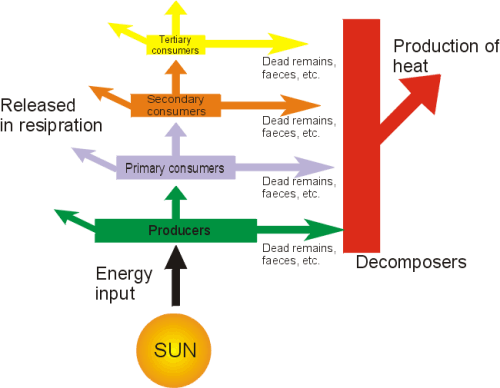Ecological Pyramids
Food webs and food chains tell us what eats what, but they tell us nothing about the numbers of individuals involved. It takes many plants to feed a few herbivores. Similarly there must be far more prey than there are predators.
Pyramids of number

Pyramids of number give us information about the numbers of individuals in each level. They are drawn up by counting the number of individuals in a certain area, 1m2 for example. These numbers are then plotted like a bar chart, but horizontally. Producers are placed on the bottom of the pyramid, above them are primary consumers and above them secondary consumers etc. These diagrams help to show that energy is lost at every step of the food chain. Of the energy the producers receive, most is used up in respiration. Only a fraction of the energy produced by photosynthesis is used by the plant for growth and the manufacture of new materials. It is this food which available to consumers and not the total amount of energy the plant receives. Generally pyramids of numbers show this concept well, but problems can occur because it does not take into account the size of the organism.

This pyramid of numbers is not pyramid shaped. Therefore using number of animals does not always give us the image we wish to portray. This is because the size of each organism is not taken into account. A tree can sustain many tiny insects.
Pyramids of Biomass
One way of over coming this problem of size of organisms, is to chart the biomass at each level. A representative sample of the organism at each level is weighed. The mass is multiplied by the estimated number in the community. In practice the dry mass is used rather than the wet mass. This because the wet mass can vary throughout the day. Below is a biomass pyramid of a rocky shore community.
Pyramids of biomass are usually much better at demonstrating the idea of energy loss as you progress down the food chain. The diagram below shows the movement of energy through the food chain, showing a pyramid shape.

Pyramids are the shape they are due to the fact that energy is lost at each trophic level. Only a fraction of the energy in a trophic level is available to be passed on in the food chain. For example, plants absorb light energy to make food by photosynthesis. The bulk of the food made is used up in respiration. Other food is lost when when the leaves fall in autumn. Only the food stored in the plant at the time it is eaten isavailable to the herbivore eating it. The herbivore will no doubt live for a while after eating its meal. It too will respire and excrete, getting rid of much of the energy it absorbed in its meal. Only a fraction of the food eaten will be used in making the animal grow. Only this will be available to the carnivore when the herbivore is eaten.
This also explains why food chains tend to be limited in length. By the time the fourth trophic level is reached to amount of energy let is very small and therefore cannot sustain a large population.
